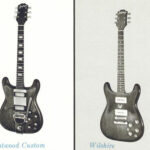Downtown Canon, a Walter Becker masterpiece, stands out as a deeply evocative song, even for listeners unfamiliar with the narrator’s experiences. Its chord progression is intricately woven to create a rich emotional landscape, shifting between shades of happiness and melancholy as the lyrics unfold. The song’s foundation is Walter’s distinctive bassline, a bouncy yet muted rhythm that injects an unsettling energy, a compelling duality of optimism and weariness. Lyrical gems like “I’m leaving with all I need, but less than I deserve” perfectly encapsulate this complex feeling. Adding to its unique character, the original recording is subtly sharp, pitched about 13 cents higher, a detail that subtly catches the ear.
Many guitarists seek to translate this rich composition to a solo guitar arrangement, capturing the essence of the full band’s sound. Initially, attempts to decipher the chords might feel incomplete. Even when friends offer chord suggestions, they may not quite resonate with the song’s true feeling. A deeper dive, perhaps at a piano, meticulously dissecting each chord and experimenting with voicings, is often necessary to truly unlock the song’s harmonic secrets. This process of detailed exploration often reveals that subtle nuances—a single note difference in a chord—can dramatically alter the emotional impact. This underscores the meticulous craftsmanship inherent in songs like Downtown Canon.
Below, you’ll find resources to aid your exploration: a chord chart outlining the basic harmonic structure and sheet music providing a visual guide.
Alt text: Detailed guitar chord chart for Downtown Canon, highlighting chord names and voicings for accurate playability.
Understanding the Provided Guitar Tablature Resources
-
Chord Chart Nuances: Be aware that the chord names provided for the intro section in the chord chart are simplified. They serve as a general guide, reflecting the harmonic pattern of the chorus’s second half. For precise note-for-note playing in the intro, refer directly to the sheet music. The sheet music accurately notates the individual notes within the arpeggiated pattern.
-
Sheet Music as a Guide: The sheet music is intended as a helpful reference, not a definitive transcription. Generated using MuseScore from a MIDI recording, it prioritizes note accuracy over rhythmic precision. Measures, rests, and rhythmic notation might not be perfectly aligned with the original recording. Focus on the notated pitches to grasp the chord voicings and then synchronize your playing with the original track to capture the correct timing and feel.
-
Simple Block Chords as Starting Points: The listed chords are presented as fundamental block chords, designed to be your foundation. Listen attentively to the Rhodes piano in the original recording. You’ll notice the incorporation of additional notes for color, and the evolving voicings throughout the song. Embrace a jazzy approach; don’t adhere rigidly to the basic chords. Experiment, improvise, and infuse your personal touch into your rendition.
To further assist your learning, a video performance of this arrangement is available online, offering another perspective and potentially clarifying any remaining questions. https://www.walterbeckermedia.com/forum/everything-else/my-cover-version-of-downtown-canon
Alt text: Excerpt of guitar sheet music for Downtown Canon, visually representing the melody and chord progression for guitarists.
By utilizing these resources and embracing an exploratory approach, you can unlock the intricacies of Downtown Canon on guitar and develop your own compelling interpretation of this remarkable song.

